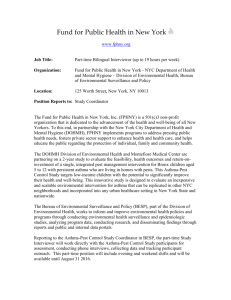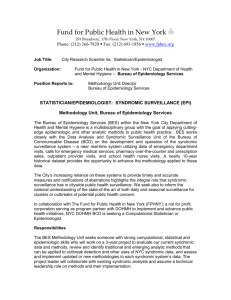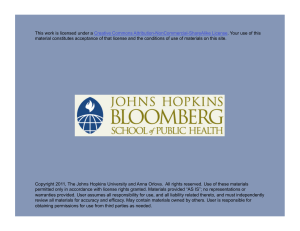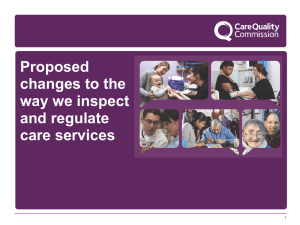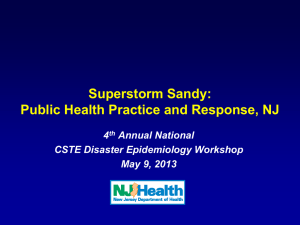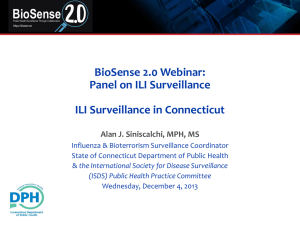presentation - The Institute for Family Health
advertisement
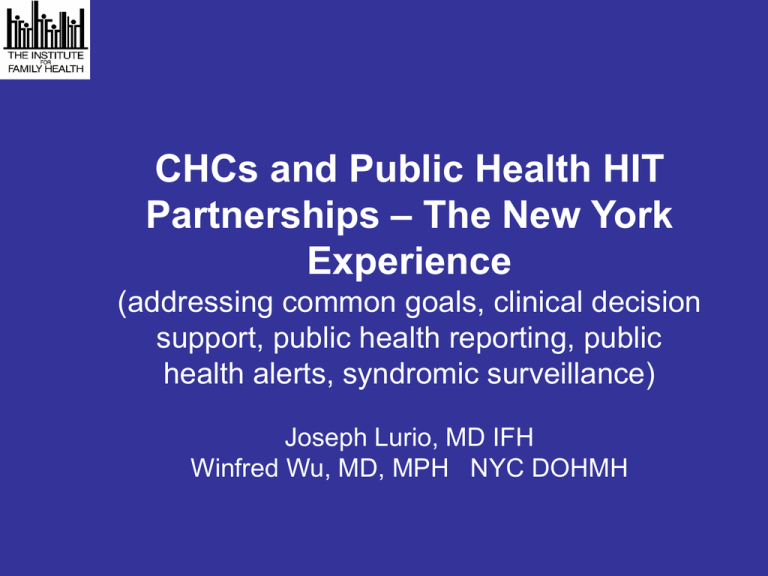
CHCs and Public Health HIT Partnerships – The New York Experience (addressing common goals, clinical decision support, public health reporting, public health alerts, syndromic surveillance) Joseph Lurio, MD IFH Winfred Wu, MD, MPH NYC DOHMH The Institute for Family Health 15 Community Health Centers – 5 Bronx, 4 Manhattan, 6 Mid-Hudson Valley 8 homeless healthcare sites 1 School based health programs 3 Dental centers 2 Community Mental Health Centers 2 Free Clinics 225,000 primary care visits 70,000 patients NYC DOHMH • Serves all five boroughs of NYC • Six Major Divisions – Disease Control – Environmental Health – Epidemiology – Health Care Access and Improvement – Health Promotion and Disease Prevention – Mental Hygiene • Staff of 6,000 Center of Excellence in Public Health Informatics Project Partners Institute for Family Health NYC DOHMH Columbia University DBMI Goals of Collaboration • Improve Function of EHR • Demonstrate How CHCs can be integrated into Public Health Infrastructure Collaborative Projects Center of Excellence (2004) New Projects (2008 - ) • TCNY • Syndromic Surveillance • Immunization Interface (Bidirectional) (NYCDOHMH & IFH) • Medlee natural language processing data extraction project (Columbia) • Reportable Disease Notification • Real Time, Alerts • Swine Flu Surveillance • SSTI (Appropriate Skin Infection Treatment) • Urine Antibiograms (Appropriate UTI Treatment) Syndromic Surveillance • Health-related data preceding diagnosis (e.g. clinical notes, absentee rates, pharm sales) to ID potential cases • Changes in signal may herald outbreaks Syndromic Surveillance Monitor for: • Influenza Like Illness (ILI) • GI illness Data Utilized • Chief Complaints • Diagnoses (filed by provider) • Vital Signs – – – – Temp Pulse BP Resp • Orders Syndromic Surveillance – ILI (Broad Definition) Two plots of IFH ILI visits defined by CC of fever vs MT > 100 NYC ED syndromic surveillance – CC based Take Care New York (TCNY) Goals – Have PCP – Healthy Heart • Diabetes Mellitus: BP/LDL/A1c • Cardiac Patients: BP/LDL – Cancer Screening • Mammo • Cervix • Colorectal – Diabetes Screening • Hypertensives • Hyperlipidemics – HIV Screening – Substance Use • Assessment (Tobacco, Alcohol, Drugs) • Smokers Taking meds • Smoker Quit Rate • Buprenorphine Treatment – Obesity • BMI Assessment • Obesity Treatment – Depression • Screening • Reassessment (Treatment) Strategy for Achieving TCNY Objectives: Integration into Clinical Workflow • Alert: Clinical Best Practice Alerts (BPAs) • Assist: Hyperlinked order sets (SmartSets) Example SmartSet 6/3 7/30 /20 8/31 /2 06 0 9/31 /2006 10 0 / 06 2 11 /31/ 006 /30 20 12 /2 06 /3 0 1/3 1/2 06 0 2/21 /2006 3/38 /2 07 0 4/31 /2007 5/30 /2 07 0 6/31 /2007 7/30 /2 07 0 8/31 /2007 9/31 /2 07 10 0 / 007 / 2 11 31/2007 12 /30/ 007 /3 20 1/3 1/2007 2/21 /2 07 0 3/39 /2008 4/31 /2 08 0 5/30 /2008 6/31 /2 08 0 7/30 /2008 8/31 /2 08 0 9/31 /2 08 10 0 /2008 11 /31/ 008 / 2 12 30/2008 /3 0 1/3 1/2 08 0 2/21 /2008 3/38 /2 09 0 4/31 /2009 5/30 /2 09 1 / 009 20 09 Percentage Percentage of Women ages 52-69 that Received a Mammogram 100 90 80 70 60 50 40 30 20 10 0 ALL Immunization Registry Interface Immunization Interface: NYC CIR Immunization Interface: Epic Immunization Interface Was it worth all that effort?: • Lots of Work to Build • Lots of Work to Maintain Integrating Public Health Alerts at the Point of Care Rapid Response To Emerging Conditions Objectives: • Decrease time to diagnosis • Opportunity for clinician to identify and treat rare conditions quickly • Increase chances for containing an epidemic Current State of Public Health Information Exchange • Health Alert Network (HAN) • MMWR • Mass media • Peer-reviewed literature • Problem: Information not integrated into clinical workflow Delivery of Public Health Information via EHRs • Enables: – Integration of information in the clinical workflow – Delivery of information in a specific and contextually relevant manner – Collection of additional • Patient history • Diagnostic tests – Up to date treatment (Via guideline transmittal & Linked Order Sets) Alert for Swine Flu Decision Support • Public Health Notices (HPN) Good • Best Practice Alerts Better “It was a dark and stormy night. Dr. Lurio’s clinic was supposed to be over at 5PM, but at 6 his nurse told him there was one more patient to be seen…” Notifiable Disease Reporting • Health providers mandated to report notifiable conditions • Reporting in NYC via paper or internet (webform) • Historically low compliance by providers – Lack of awareness • What to report • How to report – Time Improving Reporting With EHRs • EHRs can facilitate provider reporting – Notify provider when to report – Provide forms for reporting • BPA configured with hyperlinked reporting form Initial Results Initial Results Of the 34 patients where provider documented plan to report, only 6 were received at DOHMH! Next steps: Prepopulated forms specific to condition being reported H1N1 Surveillance Project Using IFH/DOHMH partnership Opportunity to address: •Proportion of ILI due to H1N1 swine influenza •Frequency of severe illness •Differences between mild and severe illness H1N1 Surveillance Project • Community surveillance project began on 5/26 • Key partners: – IFH – DOHMH – Columbia University • Value to public health and clinical community H1N1 Surveillance Project • Results to Date Weekly MassTag PCR Results 30 25 Number Positive – 114 patients tested since 5/26 – 61 (54%) positive for H1N1 – Sensitivity of rapid test: 28% (17/61) H1N1 Flu B 20 RSV 15 HPIV HMPV 10 CoV EV/RV 5 0 May 30 June 6 June 13 Week June 20 Collaboration between DOH and CHC provides mutual Benefit • DOH Requires Ambulatory Practices to act as eyes and arms • CHCs rely on DOH to provide expert guidance and situational awareness to allow effective health care delivery • Electronic Health Records are a communication tool that allows this collaboration to occur. Special thanks to: Frances Morrison2, Rachel Berg1, Michael Buck2 , Winfred Wu3, Kwame Kitson1 Farzad Mostashari4 , Neil Calman1 1 – Institute for Family Health; 2 – Columbia University; 3 – New York City Department of Health and Mental Hygiene ; 4- Office of the National Coordinator for Health IT Contact information: Joseph Lurio, MD, FAAFP Chief Medical Information Officer Institute for Family Health Email: jlurio@institute2000.org Winfred Wu, MD, MPH New York City Department of Health and Mental Hygiene Email: wwu2@health.nyc.gov
